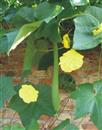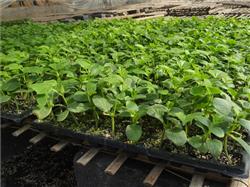How to manage the planting of towel gourd

How to manage planting towel gourd? Please help guide towel gourd heat resistance, moisture resistance is strong, but cold resistance is poor, so towel gourd often spring, summer planting, summer, autumn harvest. Towel gourd can blossom continuously and bear fruit continuously, so it is arranged to be cultivated once a year in the frost-free period in most areas. The main results are as follows: 1. Varieties should be selected for spring sowing, especially for early spring sowing, the varieties that are not easy to produce female flowers under the condition of low temperature and short day should be selected, and the varieties with early female flowers, many female flowers and poor growth should be selected for summer and autumn sowing. 2. Sowing and raising towel gourd can be cultivated by raising seedlings in advance and planting on the balcony immediately after the final frost. The balcony is generally cultivated with scaffolding (such as flat scaffolding, semicircular tunnel scaffolding). Seed disinfection, seed soaking and sprouting before sowing, treatment methods, seedbed preparation, sowing and seedling management can all refer to the seedling methods of cucumber. The time of soaking seeds is generally 8-10 hours, and sprouting can be seeded in 2-3 days. As the seeds are larger, the soil cover should reach about 1.5 cm when sowing. The suitable seedling age of towel gourd is about 40 days. It can be planted when the seedlings have 3 or 4 true leaves. The root system of towel gourd is well developed. in order to reduce the damage to the root system during transplantation and facilitate the timely recovery of growth, it is best to adopt root protection methods such as nutrition bowl for towel gourd seedlings. 3. Planting and applying sufficient base fertilizer is the key to high quality and high yield of towel gourd, and fully mature organic fertilizer can be applied to 50g / kg soil. Because of the large row spacing of towel gourd (especially the scaffolding cultivation on the southern balcony), the effect of base fertilizer is the best with ditch strip application or hole application. The distance between the planted plants is about 30cm to 50cm. The south is suitable for towel gourd growth for a relatively long period, often using scaffolding cultivation, row spacing of about 2 to 3 meters, plant spacing of 30 to 100 centimeters. Seedlings must be planted with complete soil blocks, in order to protect the roots, conducive to slow seedlings, the completion of planting should be timely watering of roots, and then according to soil moisture and weather conditions to slow down seedlings. 4. After ploughing, killing grass and watering the seedlings in time, the new leaves of the seedlings began to occur, but at this time, the seedlings were not set up, and the seedlings were small. The first intertillage should be carried out in time to loosen the soil, with the principle of not harming the roots of the seedlings and not loosening the base of the seedlings. In the second intertillage, the soil between each row should be properly cultivated on both sides of the plant roots to make the flat bed into a tile ridge, promote the occurrence of adventitious roots, expand the area of plant nutrition absorption, and enhance the absorption capacity of towel gourd. When the plant grows up and the branches and leaves climb all over the frame, the soil surface is shaded and should no longer be ploughed. If there are weeds, they should be pulled out. When towel gourd was just planted in early spring, the temperature was low, so watering should be properly controlled and mid-tillage management should be strengthened to promote the root growth of towel gourd. 5. Set up the frame in time after the second deep ploughing. The way of setting up the scaffolding should be determined according to the specific situation, the varieties with long vine, exuberant growth and strong branching force are generally, and the local suitable growth time is better to build scaffolding (such as flat scaffolding, semi-arched circular scaffolding, etc.). For the precocious varieties with weak growth potential and short vines, and the local suitable growth season is relatively short, it is appropriate to build a "human" word frame or flower rack. Before the towel gourd stem is on the shelf, it is necessary to remove the lateral buds at any time and draw the vine artificially; when introducing the vine, it can be combined with the zigzag vine according to the growth of the plant, so that the stem of the plant is evenly distributed and the growth point is at the same level. Tie the vine and fix the stem in time. When the stem of the plant climbs to the upper part of the frame, especially the cultivation of the scaffolding, the vine is no longer bound and introduced. The scaffolding must be firmly built to prevent it from collapsing during operation and when it is windy. Varieties no longer remove lateral vines, but remove overdense lateral branches, weak branches, and seriously overlapping or infected lateral vines. You can also leave 1 or 2 melons on the strong side vines and pick the heart. 6. Fertilizer and water management towel gourd is more tolerant to poor ridge, but under the condition of sufficient fertilizer and water, it has strong growth, deep roots and luxuriant leaves, many flowers and fruits, and thick and straight melon strips. Therefore, in addition to applying sufficient base fertilizer, a small amount of fertilizer can be applied when root water is poured during planting to promote slow seedling growth. Topdressing can be carried out when watering later. Towel gourd can also tolerate high concentration of fertilizer, and it is not easy to grow when there is enough fertilizer. In the whole cultivation process of towel gourd, the times and amount of topdressing should be more than that of other melons. If fertilizer is not applied in time, it is easy to lose fertilizer, resulting in yellow wilt and shedding of female flowers, and the growing fruits will develop malformed and affect the yield and quality. In actual cultivation, for every harvest of melon, fertilizer must be applied once, and ammonium sulfate 0.5 g / kg soil or urea 05 g / kg soil can be forced each time, and 0.5 g / kg soil can also be applied with chlorophosphate and potassium compound fertilizer. When applying fertilizer, it is best to bury it in the soil (compound fertilizer must be buried in the soil), dig a hole about 10 cm deep from the root of the plant, bury it in fertilizer, and water it after fertilization. Towel gourd can also be combined with medicine for foliar fertilization, such as spraying 0.4% urea solution. 7. It takes about 50 to 60 days to harvest towel gourd from planting to harvest. From 7 to 10 days after the female flower blossoms, the pedicel becomes smooth, the color of the peel becomes dark green, the hairs on the fruit surface are reduced, and the pericarp can be harvested by touching the pericarp with hands. Angular towel gourd is more prone to aging, and the general harvest time is 1 or 2 days earlier than ordinary towel gourd. When the fertilizer and water is insufficient, the fruit is easy to grow old and should be harvested early, while when there is enough fertilizer and water, the harvest can be postponed appropriately. 8. It is better to keep the towel gourd as the root gourd, which has early flowering and fruiting, long growth period, full grains, strong vitality, good seed character, and many melons. It can be harvested when the fruit is fully ripe, the pericarp hardens and the skin turns yellow. When harvesting, select the fruit shape in line with the characteristics of this variety, thick melon strips, hypertrophy of melon stalk, rapid growth and development, no diseases and insect pests as melon. Cut off the top of the melon after harvest, or make a few small holes in the top of the melon, hang it in a well-ventilated room, so that the moisture in the melon is fully dried to facilitate the extraction of seeds. When taking the seeds, tear off the outer skin, cut the melon collaterals longitudinally, pat hard, and the seeds will be scattered and dried for storage. Click for more towel gourd planting techniques click to get more vegetable planting techniques
- Prev

How to dip towel gourd in flowers
How to dip towel gourd in flowers? Please give instructions to the towel gourd dipped in flowers can refer to the following methods: first, determine the dipping time. As the temperature rises, loofah flowers open earlier, it is recommended that vegetable farmers now dip in flower time between 10: 00 a.m. and 3: 00 p.m., otherwise the flowers are big and thin, and customers are not willing to buy them. Two.
- Next

How to manage towel gourd seedlings
How to manage towel gourd seedlings? In order to make full use of the land, promote the growth of towel gourd, improve yield and efficiency, and save seeds, towel gourd should also be cultivated by raising seedlings in advance and planting immediately after the final frost. Due to the different planting density, the seed consumption of towel gourd is very different.
Related
- Where is it suitable to grow horseradish in China? it is expected to see the middle altitude horseradish in Alishan.
- How to prevent tomato virus disease reasonably? (Control methods included)
- Many people like to plant towel gourd on the balcony. What are the main points of this method and management?
- What crops can chili peppers be mixed with?
- Fertilization techniques and matters needing attention in Tomato
- What are the grafting techniques for peach seedlings in spring?
- Harm and control methods of root swelling disease of Chinese cabbage
- What are the pests of sweet potatoes? How to prevent and cure it?
- Symptoms, causes and Control methods of navel Rot in Tomato
- The cause of "Cucumber rotten bibcock" in Farmers' planting Cucumber and its Control Plan

